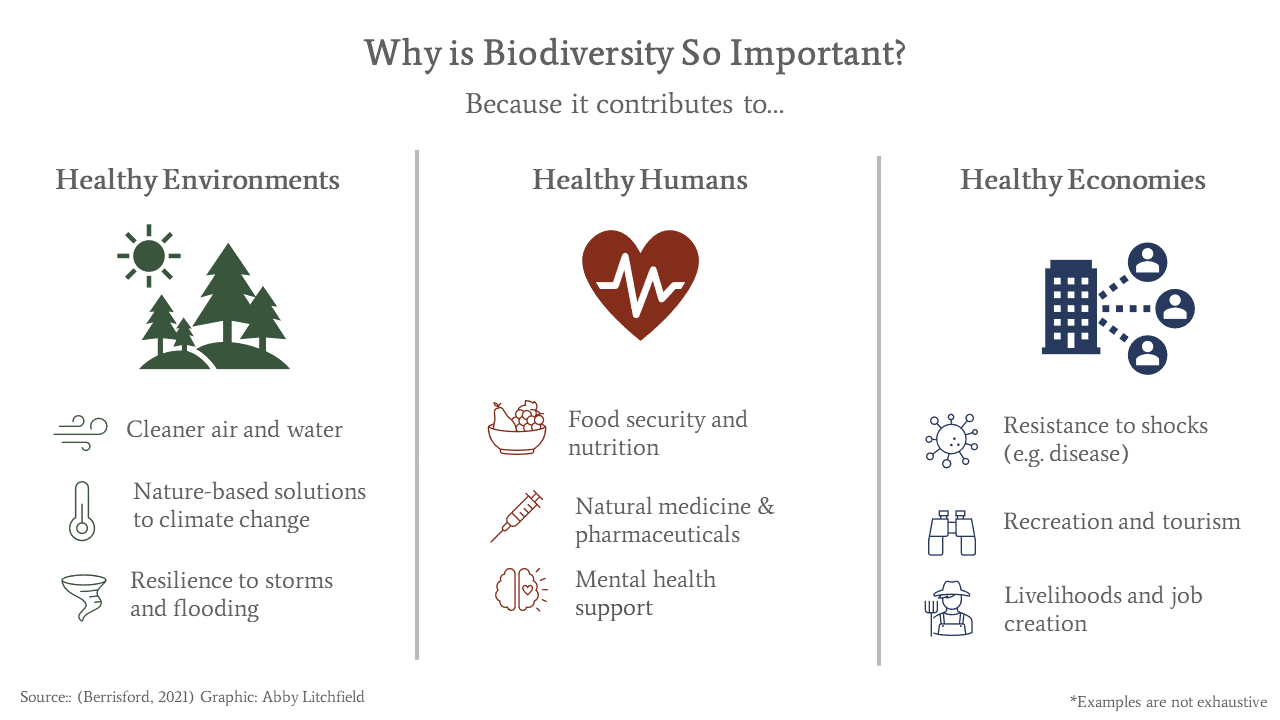Biodiversity is a solution to some of the world’s greatest challenges, from climate change to poverty to food security. It is at the heart of sustainable development.
“The Basics” provides essential knowledge about core business sustainability topics.
The term biodiversity was coined in the 1980s by combining the words ‘biological’ and ‘diversity.’ But there was recognition long before then of the importance of the variety of life on earth.
Indigenous cultures integrated nature into their worldview. In 1799, American politician Thomas Jefferson wrote about the consequences of losing biodiversity: “If one link in nature’s chain might be lost, another and another might be lost, till this whole system of things should evanish by piece-meal.”
More recently, former United National Environmental Program Director Achim Steiner described biodiversity’s different contributions: “Across cultures, humans inherently value nature. The magic of seeing fireflies flickering long into the night is immense. We draw energy and nutrients from nature. We find sources of food, medicine, livelihoods and innovation in nature. Our well-being fundamentally depends on nature.”
Biodiversity is closely connected other concepts like species and ecosystems (a geographic community of life). Today, all this natural wealth is under tremendous pressure. Species are going extinct hundreds of times faster than they normally would, due to multiple threats. A fifth of countries worldwide face potential ecosystem collapse, according to a recent report by Swiss Re.
Often climate change has seemed to get more public attention than biodiversity. But, things are changing. People are starting to recognise the connections between biodiversity, climate change, and other components of sustainable development. Biodiversity can be a “nature-based solution” to many of the Sustainable Development Goals.
For businesses, biodiversity provides challenges and opportunity. Innovative businesses are already finding ways to improve their operations while protecting the planet.
Why is biodiversity important to humans?

Almost every aspect of our lives connects to and depends on biodiversity. That includes the food we eat, the air we breathe, and the happiness we feel when surrounded by the beauty of nature.
Biodiversity has practical value: In the words of United Nations leader Cristiana Paşca Palmer, it is an “infrastructure” supporting life on earth. Like any infrastructure, it provides basic equipment and structures we need to operate. Biodiversity, in the form of healthy ecosystems, filters our air and water; it keeps our soil healthy and provides ecological buffers against storm damage. In these ways, biodiversity provides “nature-based solutions” to problems that we often address with human engineering. (Diversity helps make ecosystems healthy and productive, resilient to shocks and changes.)
Biodiversity is also the foundation for many of our jobs and livelihoods. The agricultural sector, for example, employs a billion people worldwide. A third of global agricultural land relies on pollinators: animals and insects that move pollen and thus allow plants to produce seeds. As part of the general decline in biodiversity, pollinator numbers have plummeted, causing economic losses as much as USD $577 billion each year.
The amazing wealth of species on earth (e.g. 391,000 plants) leads to expressions like biodiversity being “nature’s storehouse.” We’re able to draw on nature for all kinds of innovations and solutions. For example, plants and other natural sources have long been the basis for drug development, and most of the world’s population still relies on natural medicines for their healthcare.
Finally, exposure to nature feeds our souls and helps us thrive. We learn faster. We act nicer. “Man’s heart, away from nature, becomes hard,” said Indigenous leader Chief Luther Standing Bear. “Lack of respect for growing, living things led to lack of respect for humans too.”
How to measure the value of biodiversity
We all attach different values to biodiversity and nature. For some, there’s spiritual value, or the enjoyment of being in in natural settings. Many of us also value more concrete benefits that nature provides, from physical “goods” like food and building materials to “services” like filtering our water.
Economists have tried to put an economic value on nature and ecosystem services. This can be quite complex and there are arguments about how to do it. Mostly, they look at the cost of replacing ecosystem goods and services if they are destroyed or reduced. For example: how much would it cost to purify water using engineered solutions if a natural watershed was destroyed?
Yet, some species or ecosystem services are priceless. What if the species that holds the cure to cancer becomes extinct?
Though it’s challenging to calculate the financial value of nature, numbers are important for decision-making. They also help us appreciate what the loss of biodiversity means. For example, the value of ecosystems to human livelihoods and well-being is worth $USD 125 trillion per year, according to WWF’s Living Planet Report.
The importance of biodiversity for business
Like other organizations and individuals, businesses influence and depend on nature. Many businesses realize that protecting and restoring nature can help them stay operational (avoiding risks) and even thrive: leading to new markets, sustainable supply chains, and lower operating costs.
It’s helpful to measure an organization’s impacts on biodiversity and then work to improve them. The Kering Group, a luxury conglomerate, has taken this approach. They have a Biodiversity Impact Metric, and communicate their results annually in an Environmental Profit and Loss (EP&L) report). Analysis showed that their negative impact came largely from supply chain activities—particularly the ways they produced and processed raw materials.
Companies can also pivot to address customer demand for sustainable products, services and operations. There’s an emerging “restoration economy,” where companies seek to restore land and biodiversity even as they provide products or services. Clothing company Tentree, for example, plants 10 trees for every piece of clothing it sells, linking its sales to habitat restoration. To date, it has planted over 25 million trees.
Social entrepreneurs also find new business models tackling threats to biodiversity. The Sustainable Oceans Alliance, a business accelerator in Canada, helps entrepreneurs scale solutions for ocean restoration. One startup, PlanetCare, has designed a microfiber filter for washing machines to prevent microplastic waste from entering water systems and oceans. CoralVita develops climate-resilient corals to help restore degraded coral reefs; it sells this service to fishing operators, tourism businesses, and others who depend on the ecosystem services that reefs provide.
Biodiversity represents life on earth. As such, it’s tightly interwoven with all our activites. Finding ways to conserve and restore biodiversity enables humanity and business to thrive. Mark Gough, CEO of the Natural Capital Coalition, describes the potential: “Businesses across the globe are increasingly recognising that a healthy natural world is not only a nice to have, but a critical asset which underpins their continued growth and success.”
About the Series
“The Basics” provides essential knowledge about core business sustainability topics. All articles are written or reviewed by an expert in the field. The Network for Business Sustainability builds these articles for business leaders thinking ahead.
About the Author
Kate Berrisford uses communication, partnerships and research to create positive impact. She has a law degree (LLB) and a Masters degree in environmental management (MPhil). Based in South Africa, she has centred her work on topics including climate change, biodiversity, and urban sustainability. She co-authored the Local Action for Biodiversity Guidebook for ICLEI – Local Governments for Sustainability, coordinated the drafting of the Durban Commitment on Biodiversity, founded and managed the Green Africa Directory, and was lead author of the UNEP, UN-HABITAT and ICLEI publication Viumbe Hai: African Cities, Ecosystems and Biodiversity.
Kate recommends these resources:
IPBES 2019. Global assessment report on biodiversity and ecosystem services of the Intergovernmental Science-Policy Platform on Biodiversity and Ecosystem Services. E. S. Brondizio, J. Settele, S. Díaz, and H. T. Ngo (editors). IPBES secretariat, Bonn, Germany.
WWF. 2018. Living planet report – 2018: Aiming higher. Grooten, M. and Almond, R.E.A. (Eds). WWF, Gland, Switzerland.
WWF 2020. Living planet report 2020 – Bending the curve of biodiversity loss. Almond, R.E.A., Grooten M. and Petersen, T. (Eds). WWF, Gland, Switzerland.
Kering Group. 2019. Environmental Profit and Loss (EP&L) report. The Kering Group, Paris, France.
UN Environment. 2019. Global environment outlook – GEO-6: Healthy planet, healthy people. Nairobi.
United Nations Environment Programme. 2021. Adapt to survive: Business transformation in a time of uncertainty. UNEP, Nairobi.
Faith, Daniel P. 2021. Biodiversity. The Stanford encyclopedia of philosophy (Spring 2021 Edition). Edward N. Zalta (Ed.).



Add a Comment
This site uses User Verification plugin to reduce spam. See how your comment data is processed.This site uses User Verification plugin to reduce spam. See how your comment data is processed.